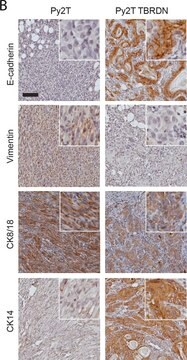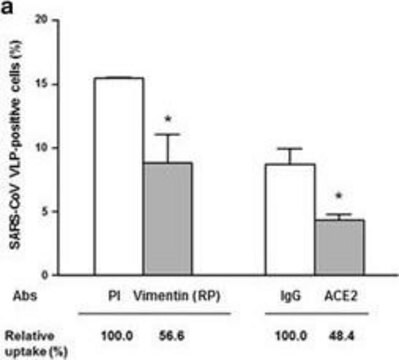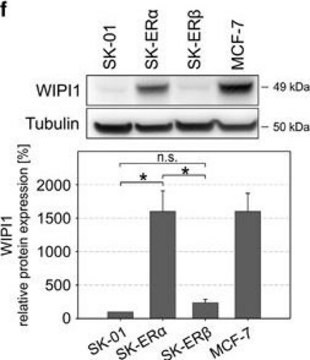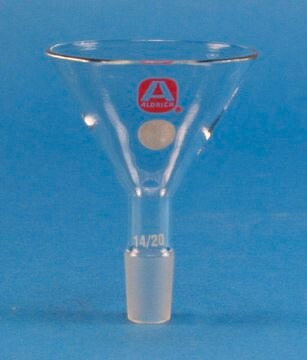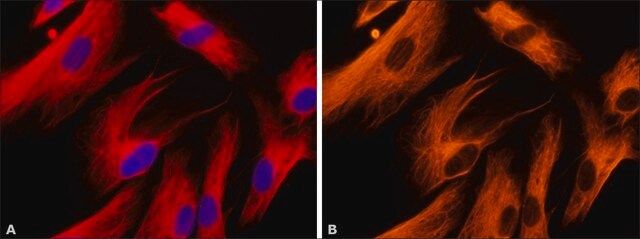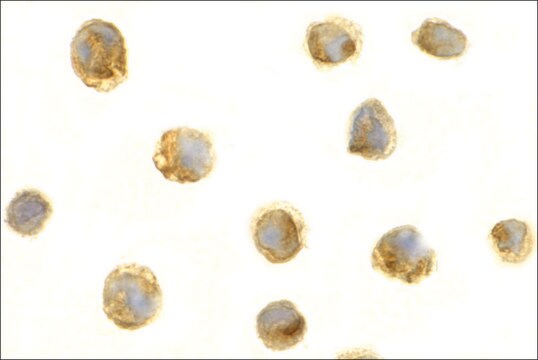W4769
Monoclonal Anti-WIPI-1 antibody produced in mouse
~1.5 mg/mL, clone WIPI1-4, purified immunoglobulin, buffered aqueous solution
别名:
Anti-ATG18, Anti-WIPI-1α, Anti-WIPI49
登录查看公司和协议定价
所有图片(2)
About This Item
分類程式碼代碼:
12352203
共軛:
unconjugated
application:
WB
無性繁殖:
WIPI1-4, monoclonal
物種活性:
human, mouse, bovine, rat
citations:
2
技術:
western blot: 2-4 μg/mL using whole extract of G361 cells
推荐产品
生物源
mouse
共軛
unconjugated
抗體表格
purified immunoglobulin
抗體產品種類
primary antibodies
無性繁殖
WIPI1-4, monoclonal
形狀
buffered aqueous solution
分子量
antigen ~49 kDa
物種活性
human, mouse, bovine, rat
濃度
~1.5 mg/mL
技術
western blot: 2-4 μg/mL using whole extract of G361 cells
UniProt登錄號
運輸包裝
dry ice
儲存溫度
−20°C
目標翻譯後修改
unmodified
基因資訊
human ... WIPI1(55062)
mouse ... Wipi1(52639)
rat ... Wipi1(303630)
一般說明
Monoclonal Anti-WIPI-1 (mouse IgG1 isotype) is derived from the hybridoma WIPI1-4 produced by the fusion of mouse myeloma cells and splenocytes from BALB/c mice immunized with a synthetic peptide corresponding to a fragment of human WIPI-1, conjugated to KLH. WIPI-1 (WD repeat domain phosphoinositide-interacting protein 1) the mammalian orthologue of Atg18 in S. cerevisiae and A. thaliana, is a member of the WIPI subfamily of WD-repeat (Trp-Asp) proteins. WIPI-1 has a 7-bladed propeller structure and contains a conserved motif for interaction with phospholipids. WIPI-1 is expressed in normal human tissues with high levels in skeletal muscle, heart and testis.
應用
Monoclonal Anti-WIPI-1 antibody has been used in immunoblotting, immunoprecipitation.
生化/生理作用
WIPI-1 (WD repeat domain phosphoinositide-interacting protein 1) plays an important role in signal transduction, transcription regulation and apoptosis. Endogenous WIPI-1 partially colocalizes with the autophagosomal marker LC3 and induction of autophagy leads to the accumulation of WIPI-1 in large vesicular and cup-shaped structures that are characteristic for autophagy-linked proteins. WIPI-1 is aberrantly expressed in human cancer and is linked to starvation induced autophagy.
外觀
0.01M 磷酸缓冲盐溶液,pH 7.4,含 15mM 叠氮化钠。
免責聲明
Unless otherwise stated in our catalog or other company documentation accompanying the product(s), our products are intended for research use only and are not to be used for any other purpose, which includes but is not limited to, unauthorized commercial uses, in vitro diagnostic uses, ex vivo or in vivo therapeutic uses or any type of consumption or application to humans or animals.
未找到合适的产品?
试试我们的产品选型工具.
Noboru Mizushima et al.
Cell structure and function, 27(6), 421-429 (2003-02-11)
Macroautophagy is an intracellular degradation system for the majority of proteins and some organelles. The molecular mechanism of autophagy has been extensively studied using the yeast, Saccharomyces cerevisiae, during these past 10 years. These studies suggested that the molecular machinery
Human WIPI-1 puncta-formation: a novel assay to assess mammalian autophagy
Proikas-Cezanne T, et al.
Febs Letters, 581(18), 3396-3404 (2007)
Tassula Proikas-Cezanne et al.
FEBS letters, 581(18), 3396-3404 (2007-07-10)
Autophagy depends on the activity of phosphoinositide-3 kinase class III to generate PI(3)P. We identified the human WIPI protein family of PI(3)P-binding factors and showed that WIPI-1 (Atg18) is linked to autophagy in human cells. Induction of autophagy by rapamycin
WIPI-1alpha(WIPI49), a member of the novel 7-bladed WIPI protein family, is aberrantly expressed in human cancer and is linked to starvation-induced autophagy
Proikas-Cezanne T, et al.
Oncogene, 23(58), 9314-9314 (2004)
Tassula Proikas-Cezanne et al.
Oncogene, 23(58), 9314-9325 (2004-12-17)
WD-repeat proteins are regulatory beta-propeller platforms that enable the assembly of multiprotein complexes. Here, we report the functional and bioinformatic analysis of human WD-repeat protein Interacting with PhosphoInosides (WIPI)-1alpha (WIPI49/Atg18), a member of a novel WD-repeat protein family with autophagic
我们的科学家团队拥有各种研究领域经验,包括生命科学、材料科学、化学合成、色谱、分析及许多其他领域.
联系技术服务部门